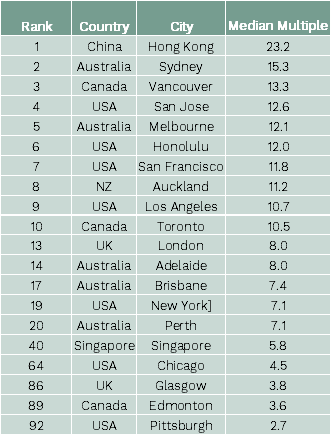The annual Demographia International Housing Affordability study identifies the housing affordability position of 96 major cities across the world. The study doesn’t include all major countries but does include the USA, China, United Kingdom, Canada, Australia, New Zealand, Ireland, and Singapore. The study notes that housing affordability has worsened across all study countries since the start of the Covid-19 pandemic where house prices have been driven up by the “movement of households from denser urban neighbourhoods to larger homes with larger yards in suburban areas” (Demographia, 2022).
Housing affordability is measured in the Demographia study as the median house price divided by the gross median household income (pre-tax). This provides a median multiple which is essentially the number of years it takes the median household in a city to pay for the median house. This is a fairly basic measure of housing affordability but is appropriate for an international study given the difficulty in comparing results across different countries.
In 2022 the Demographia housing affordability study found that the Hong Kong median multiple of 23.2 was the highest of all 96 cities in the study. Sydney came in second with a median multiple of 15.3. This was an increase of 4.3 (times the median household income) from 2019, before the Covid-19 pandemic began. To put this in a historical context, Sydney’s total median multiple in 1986 was only 4.5. That is, in 1986 it took only 4.5 years of earnings for a household to afford the median house in Sydney, where as in 2021 it takes 15.3 years.

Source: 2022 Demographia International Housing Affordability, March 2022
Australian cities feature prominently in the top 20 of the most unaffordable cities in the world. After Sydney in second place, Melbourne is fifth with a median multiple of 12.1; Adelaide is 14th (8.0); Brisbane is 17th (7.4); and Perth is in 20th place (7.1).
All of these Australian cities are considered ‘Severely Unaffordable’ (median multiple of 5.1 or higher) as are 49 of the 92 cities in the study. This is a continuation of a long term deterioration of housing affordability since 1990 when most housing markets in Australia were considered “affordable” with median multiples of 3.0 or less (Demographia, 2022).
Housing affordability has become the leading issue in the property sector and with limited action the likelihood of reversing the deteriorating position in Australia is unlikely. Many of the policies we are seeing from government are focused more on increasing the demand side rather than the supply side or on cutting the underlying costs of housing.
Unfortunately we have reached a point where we have limited options. Time has run out. We need to pursue the following strategies with haste:
For more economic insight into Australia’s economic market, please contact our specialist directly.
Senior Consultant